Denela 5% Cream

|
Product |
UK- Denela® 5% Cream |
PIL Code |
A1000354/3 |
Date started 05.04.2013 | ||
|
Artwork |
PIL for 5g tube pack |
Version |
001 |
aw/v 001/Approved 11.11.2013 |
Author |
MP-AUD |
|
Notes |
Finished size: 218mm high x 148mm wide (when folded) 4pp |
I
Back cover | Front cover
148mm | 148mm
4. Possible side effects
PATIENT INFORMATION LEAFLET
Height
218mm
Like all medicines, Denela Cream can cause side effects, although not everybody gets them.
Severe allergic reactions (rare, affect less than 1 in 1,000 people):
If you have a severe allergic reaction, stop using Denela Cream and see a doctor straight away. The signs may include sudden onset of:
• Rash.
• Feeling short of breath.
• Low blood pressure, which may make you feel faint or dizzy.
• Swelling of the face, lips, tongue or other parts of the body.
Bluish-grey skin in children (rare, affects less than 1 in 1,000 children):
In children, the skin may become bluish-grey due to a lack of oxygen. If this happens to your child, see a doctor straight away.
Other possible side effects:
Common (affect less than 1 in 10 people):
• Redness, slight swelling, or pale skin where the cream was used. This usually goes away after a short time.
Uncommon (affect less than 1 in 100 people):
• A mild burning or itching sensation when the cream is put on the skin. (When Denela Cream is used on the genitals, this is a common side effect, affecting less than 1 in 10 people.)
• A tingling feeling where the cream was put on the skin.
Rare (affect less than 1 in 1,000 people):
• Mild allergic reactions (which may cause rash or swelling).
• Small red dots on the skin where the cream was applied. This is more likely in children with skin problems such as 'atopic dermatitis' or 'mollusca'.
• Eye irritation after getting cream into your eyes by mistake.
If any of the above side effects are troublesome or last more than a few days or if you notice any side effects not mentioned in this leaflet, please inform your doctor, pharmacist or nurse.
5. How to store DENELA CREAM
Keep all medicines out of the reach and sight of children.
Store below 25°C and do not freeze.
This medicine should be disposed of 3 months after first opening.
Do not use the Denela Cream after the expiry date which is shown on the tube.
Medicines should not be disposed of via wastewater or household waste. Ask your pharmacist how to dispose of medicines that are no longer required. This will help to protect the environment.
6. Contents of the pack and other information
What Denela Cream contains:
The active substances are lidocaine and prilocaine.
Each gram of cream contains 25 mg of lidocaine and 25 mg of prilocaine.
The other ingredients are macrogolglycerol hydroxystearate, carbomer, sodium hydroxide and purified water.
What Denela Cream looks like and contents of the pack:
Denela 5% Cream is a white soft cream.
Your cream will come in a pre-medication pack containing 5 tubes of cream and 12 dressings, or in a pack containing 1 tube of cream and 2 dressings, or in a tube containing 5 g of cream without any dressings. Not all pack sizes may be marketed.
DENELA® 5% CREAM (For 5 g and pre-medication packs) Lidocaine 2.5%, Prilocaine 2.5%
Read all of this leaflet carefully because it contains important information for you.
This medicine is available without prescription. However you still need to use Denela Cream carefully to get the best results from it.
• Keep this leaflet. You may need to read it again.
• Ask your doctor, pharmacist or nurse if you need more information or advice.
• If any of the side effects gets serious, or if you notice any side effect not listed in this leaflet, please tell your doctor, pharmacist or nurse.
In this leaflet:
1. What DENELA CREAM is and what it is used for
2. What you need to know before you use DENELA CREAM
3. How to use DENELA CREAM
4. Possible side effects
5. How to store DENELA CREAM
6. Contents of the pack and other information
1. What DENELA CREAM is and what it is used for
Denela Cream contains two medicines called lidocaine and prilocaine. These belong to a group of medicines called local anaesthetics.
Denela Cream works by numbing the surface of the skin for a short time. It is put on the skin before certain medical procedures. This helps to stop pain on the skin.
It can be used to numb the skin before:
• Having a needle put in (for example, if you are having an injection or a blood test).
• Minor skin operations.
• Some types of skin graft.
• Cleansing or debridement of leg ulcers
It can also be used on adults to numb the genitals before:
• Having an injection.
• Medical procedures such as removal of warts.
A doctor or nurse should supervise the use of Denela Cream on the genitals.
2. What you need to know before you use DENELA CREAM
Do not use Denela Cream if:
• You are allergic (hypersensitive) to lidocaine, prilocaine or any of the other ingredients of Denela Cream (listed in Section 6: Further information).
• Do not use Denela Cream on premature babies (gestational age less than 37 weeks).
• Do not use Denela Cream on babies aged 0 to 12 months who are being treated with medicines called ‘sulphonamides’ such as sulfamethoxazole.
Do not use this medicine if any of the above apply to you. If you are not sure, talk to your doctor or pharmacist before using Denela Cream.
Marketing authorisation holder:
Auden Mckenzie (Pharma Division) Ltd., Mckenzie House, Bury Street, Ruislip, Middlesex, HA4 7TL, UK Manufacturer:
Tiofarma B.V., Benjamin Franklinstraat 7-9,3261 LW Oud-Beijerland, The Netherlands This leaflet was last revised in July 2013.
For information in large print, on tape, on CD or in Braille, phone +44 (0)1895 627 420.
A1000354/3
o
Auden Mckenzie
Warnings and precautions
Check with your doctor, pharmacist or nurse before using Denela Cream if:
■ You or your child are anaemic (a blood problem which means you have too few red blood cells).
• You or your child have a rare inherited illness that affects the blood called 'glucose-6-phosphate dehydrogenase deficiency'.
■ You or your child have a problem with blood pigment levels called 'methaemoglobinaemia'.
• You or your child have a skin condition called 'atopic dermatitis'. This is because the cream may need to be put on the skin for a shorter time.
If you are not sure if any of the above apply to you, talk to your doctor or pharmacist before taking this medicine.
continued on the other side
Inside spread - p2 148mm
Inside spread - p3 148mm

|
Product |
UK- Denela® 5% Cream |
PIL Code |
A1000354/3 |
Date started 05.04.2013 | ||
|
Artwork |
PIL for 5g tube pack |
Version |
001 |
aw/v 001/Approved 11.11.2013 |
Author |
MP-AUD |
|
Notes |
Finished size: 218mm high x 148mm wide (when folded) 4pp |
Other medicines and Denela Cream
Please tell your doctor or pharmacist if you are taking or have recently taken any other medicines. This includes medicines obtained without a prescription, including herbal medicines. This is because Denela Cream can affect the way some other medicines work. Also some medicines can affect the way Denela Cream works.
In particular, tell your doctor, pharmacist or nurse if you or your child have recently used or been given any of the following medicines:
• Medicines called 'sulphonamides' such as sulfamethoxazole.
• Other local anaesthetics.
• Medicines to treat an uneven heart beat, such as mexiletine or amiodarone.
If you are unsure of the types of medicines you are taking, ask your doctor or pharmacist.
Pregnancy and breast feeding
• Talk to your doctor, pharmacist or nurse before using Denela Cream if you are pregnant, may become pregnant or are breast-feeding.
• The medicines in Denela Cream (lidocaine and prilocaine) are passed into breast milk. However, the amount is so small that there is generally no risk to the child.
Ask your doctor or pharmacist for advice before taking any medicine if you are pregnant or breast-feeding.
Important information about some of the ingredients of Denela Cream
Denela Cream contains macrogolglycerol hydroxystearate (hydrogenated polyoxyl castor oil). This may cause skin reactions.
Children:
Use on the skin before small procedures (such as having a needle put in or minor skin operations): Application time: approx. 1 hour.
Newborn infants and infants under the age of 3 months: Up to 1 g of cream on a skin area not larger than 10 cm2 (10 square centimetres) in size. Application time: 1 hour, not more. Only one single dose should be given in any 24 hour period.
Infants aged 3-12 months: Up to 2 g of cream on a total skin area not larger than 20 cm2 (20 square centimetres) in size.
Application time: approx. 1 hour, maximum 4 hours.
Children aged 1 -6 years: Up to 10 g of cream on a total skin area not larger than 100 cm2 (100 square centimetres) in size.
Application time: approx. 1 hour, maximum 5 hours.
Children aged 7-11 years: Up to 20 g of cream on a total skin area not larger than 200 cm2 (200 square centimetres) in size. Application time: approx. 1 hour, maximum 5 hours.
A maximum of 2 doses at least 12 hours apart may be given to children over 3 months of age in any 24 hour period.
Applying the correct dose
Cream applied to a circular area with a diameter of about 18 mm (a 1 pence coin) and depth of about 5 mm is equal to 1 g of Denela cream.
When you apply the cream, it is very important to exactly follow the instructions below:
Height
218mm
Always use Denela Cream exactly as your doctor, pharmacist or nurse has told you. You should check with your doctor, pharmacist or nurse if you are not sure.
Do not use Denela Cream on the following areas:
• Cuts, grazes or wounds.
• Where there is a skin rash or eczema.
• In or near the eyes.
• Inside the nose, ear or mouth.
• In the back passage (anus).
• On the genitals of children.
Using Denela Cream
• Where to put the cream, how much to use and how long to leave it on for will depend on what it is needed for.
■ Your doctor, pharmacist or nurse will put the cream on or show you how to do it yourself.
• If applying the cream yourself, before you do you must get dressings from your doctor, nurse or pharmacist to use with Denela.
■ When Denela Cream is used on the genitals, a doctor or nurse should supervise its use.
Adults and adolescents aged 12 years and over:
Use on the skin before small procedures (such as having a needle put in or minor skin operations)
The cream is put on to the skin in a thick layer. Your doctor, pharmacist or nurse will tell you where to put it. The usual dose is 2 g applied for 1 to 5 hours under a dressing.
Use on the skin before hospital procedures (such as split-skin grafting) that require deeper skin anaesthesia
The usual dose is 1.5 g to 2 g of cream for each area of skin that is 10 cm2 (10 square centimetres) in size, applied for 2 to 5 hours under a dressing.
Use on larger areas of newly shaven skin before outpatient procedures (such as hair removal techniques)
The usual dose is 1.5 g of cream for each area of skin that is 10 cm2 (10 square centimetres) in size, applied for 1 to 5 hours under a dressing. Denela Cream should not be used on an area of newly shaven skin larger than 600 cm2 (600 square centimetres, e.g. 30 cm by 20 cm) in size. The maximum dose is 60 g.
Use on genital skin before injections of local anaesthetics (adult men only)
The usual dose is 1 g of cream for each area of skin that is 10 cm2 (10 square centimetres) in size, applied for 15 minutes under a dressing. Use on genital skin before minor skin surgery (such as removal of warts for adults only)
The usual dose is 5 g to 10 g of cream applied for 10 minutes with no dressing. The medical procedure should then start immediately. Use on leg ulcers before cleaning or debridement
The usual dose is 1 g to 2 g of cream for each area of skin that is 10 cm2 up to a total of 10 g. The cream is put on under an airtight dressing such as plastic wrap. This is done for 30 to 60 minutes before the ulcer is to be cleansed. Remove the cream with cotton gauze and start cleansing without delay.
Denela Cream can be used before cleansing of leg ulcers for up to 15 times over a period of 1-2 months.
1. Squeeze 'A tube in a mound on the area to be anaesthetised.
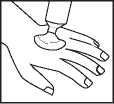
2. Do not rub the cream in.
3. Peel the paper layer from the dressing.
|
Jfk | |
5. Remove the backing. Smooth down the edges of the dressing carefully.
Then leave it in place for at least 60 minutes.
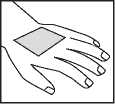
4. Remove the covers of the dressing. Then place the dressing carefully over the mound of cream.
Do not spread the cream under the dressing.

6. Your doctor or nurse will take the dressing off and remove the cream just before they do the medical procedure (for example just before the needle is put in).

What to do if you get Denela Cream in your eye:
* Do not get Denela Cream in your eyes. This is because it may irritate your eyes.
* If you get Denela Cream in your eye by mistake, rinse your eye well with lukewarm water or salt (sodium chloride) solution.
Be careful to avoid getting anything in your eye until feeling returns.
If Denela Cream is accidentally swallowed, talk to your doctor, pharmacist or nurse straight away.
If you use more Denela Cream than you should:
* If you use more Denela Cream than your doctor, pharmacist or nurse has told you to, talk to one of them straight away, even if you do not feel any symptoms.
* Symptoms of using too much Denela Cream are listed below. These symptoms are unlikely to happen if Denela Cream is used as recommended.
D> Feeling light-headed or dizzy.
t> Tingling of the skin around the mouth and numbness of the tongue.
D> Abnormal taste. t> Blurred vision.
D> Ringing in the ears.
t> There is also a risk of 'methaemoglobinaemia' (a problem with blood pigment levels).
This is more likely in children and when certain medicines have been taken at the same time. If this happens, the skin becomes bluish-grey due to a lack of oxygen.
* In serious cases of overdose, symptoms may include fits, low blood pressure, slowed breathing, stopped breathing and altered heart beat. These effects may be life-threatening.
If you have any further questions on the use of this product, ask your doctor, pharmacist or nurse.
continued on the other side

|
Product |
UK Denela® 5% Cream |
PIL Code |
A1000169/3 |
Date started 05.04.2013 | ||
|
Artwork |
PIL 8i SPC/TL for 30g tube pack |
Version |
001 |
aw/v Final outlined files - 12.11.2013 |
Author |
MP-AUD |
|
Notes |
Size: 380mm high x 340mm wide (flat) 4pp - 380mm high x 170mm wide (folded) |
I
Back cover I Front cover
170mm I 170mm
Overall height 380mm

• In serious cases of overdose, symptoms may include fits, low blood pressure, slowed breathing, stopped breathing and altered heart beat. These effects may be life-threatening.
If you have any further questions on the use of this product, ask your doctor, pharmacist or nurse.
4. Possible side effects
Like all medicines, Denela Cream can cause side effects, although not everybody gets them.
Severe allergic reactions (rare, affect less than 1 in 1,000 people):
If you have a severe allergic reaction, stop using Denela Cream and see a doctor straight away. The signs may include sudden onset of:
• Rash.
• Feeling short of breath.
• Low blood pressure, which may make you feel faint or dizzy.
• Swelling of the face, lips, tongue or other parts of the body.
Bluish-grey skin in children (rare, affects less than 1 in 1,000 children):
In children, the skin may become bluish-grey due to a lack of oxygen. If this happens to your child, see a doctor straight away.
Other possible side effects:
Common (affect less than 1 in 10 people):
• Redness, slight swelling, or pale skin where the cream was used. This usually goes away after a short time. Uncommon (affect less than 1 in 100 people):
• A mild burning or itching sensation when the cream is put on the skin. (When Denela Cream is used on the genitals, this is a common side effect, affecting less than 1 in 10 people.)
• A tingling feeling where the cream was put on the skin.
Rare (affect less than 1 in 1,000 people):
• Mild allergic reactions (which may cause rash or swelling).
• Small red dots on the skin where the cream was applied. This is more likely in children with skin problems such as 'atopic dermatitis' or 'mollusca'.
• Eye irritation after getting cream into your eyes by mistake.
If any of the above side effects are troublesome or last more than a few days or if you notice any side effects not mentioned in this leaflet, please inform your doctor, pharmacist or nurse.
5. How to store DENELA CREAM
Keep all medicines out of the reach and sight of children.
Store below 25°C and do not freeze.
This medicine should be disposed of 3 months after first opening.
Do not use the Denela Cream after the expiry date which is shown on the tube.
Medicines should not be disposed of via wastewater or household waste. Ask your pharmacist how to dispose of medicines that are no longer required. This will help to protect the environment.
6. Contents of the pack and other information
What Denela Cream contains:
The active substances are lidocaine and prilocaine.
Each gram of cream contains 25 mg of lidocaine and 25 mg of prilocaine.
The other ingredients are macrogolglycerol hydroxystearate, carbomer, sodium hydroxide and purified water.
What Denela Cream looks like and contents of the pack:
Denela 5% Cream is a white soft cream.
Your cream will come in a tube containing 30 g of cream without any dressings. A wooden spatula is enclosed for applying your cream.
Marketing authorisation holder:
Auden Mckenzie (Pharma Division) Ltd.
Mckenzie House,
Bury Street, Ruislip,
Middlesex, HA4 7TL, UK
Manufacturer:
Tiofarma B.V.
Benjamin Franklinstraat 7-9 3261 LW Oud-Beijerland The Netherlands
This leaflet was last revised in July 2013.
For information in large print, on tape, on CD or in Braille, phone +44 (0)1895 627 420.
A1000169/3 Auden Mckenzie
PATIENT INFORMATION LEAFLET
DENELA® 5% CREAM (For 30 g surgical packs)
Lidocaine 2.5%, Prilocaine 2.5%
Read all of this leaflet carefully because it contains important information for you.
This medicine is available without prescription. However you still need to use Denela Cream carefully to get the best results from it.
• Keep this leaflet. You may need to read it again.
• Ask your doctor, pharmacist or nurse if you need more information or advice.
• If any of the side effects gets serious, or if you notice any side effect not listed in this leaflet, please tell your doctor, pharmacist or nurse.
In this leaflet:
1. What DENELA CREAM is and what it is used for
2. What you need to know before you use DENELA CREAM
3. How to use DENELA CREAM
4. Possible side effects
5. How to store DENELA CREAM
6. Contents of the pack and other information
1. What DENELA CREAM is and what it is used for
Denela Cream contains two medicines called lidocaine and prilocaine. These belong to a group of medicines called local anaesthetics.
Denela Cream works by numbing the surface of the skin for a short time. It is put on the skin before certain medical procedures. This helps to stop pain on the skin.
It can be used to numb the skin before:
• Having a needle put in (for example, if you are having an injection or a blood test).
• Minor skin operations.
• Some types of skin graft.
• Cleansing or debridement of leg ulcers
It can also be used on adults to numb the genitals before:
• Having an injection.
• Medical procedures such as removal of warts.
A doctor or nurse should supervise the use of Denela Cream on the genitals.
2. What you need to know before you use DENELA CREAM
Do not use Denela Cream if:
• You are allergic (hypersensitive) to lidocaine, prilocaine or any of the other ingredients of Denela Cream (listed in Section 6: Further information).
• Do not use Denela Cream on premature babies (gestational age less than 37 weeks).
• Do not use Denela Cream on babies aged 0 to 12 months who are being treated with medicines called 'sulphonamides' such as sulfamethoxazole.
Do not use this medicine if any of the above apply to you. If you are not sure, talk to your doctor or pharmacist before using Denela Cream.
Warnings and precautions
Check with your doctor, pharmacist or nurse before using Denela Cream if:
• You or your child are anaemic (a blood problem which means you have too few red blood cells).
• You or your child have a rare inherited illness that affects the blood called 'glucose-6-phosphate dehydrogenase deficiency'.
• You or your child have a problem with blood pigment levels called 'methaemoglobinaemia'.
• You or your child have a skin condition called 'atopic dermatitis'. This is because the cream may need to be put on the skin for a shorter time.
If you are not sure if any of the above apply to you, talk to your doctor or pharmacist before taking this medicine.
Other medicines and Denela Cream
Please tell your doctor or pharmacist if you are taking or have recently taken any other medicines. This includes medicines obtained without a prescription, including herbal medicines. This is because Denela Cream can affect the way some other medicines work. Also some medicines can affect the way Denela Cream works.
In particular, tell your doctor, pharmacist or nurse if you or your child have recently used or been given any of the following medicines:
• Medicines called 'sulphonamides' such as sulfamethoxazole.
• Other local anaesthetics.
• Medicines to treat an uneven heart beat, such as mexiletine or amiodarone.
If you are unsure of the types of medicines you are taking, ask your doctor or pharmacist.
J 7 r continued on the other side
PIL height 296mm
r
g/ Of? Of of os V 0/ g/ g^ os of of of ^ q^ Q> a/ q^ ax' ox qx 9X qx qx qx qx qx qx qx qx V qx qx qx qx qx qx qx qx qx qx qx qx qx qx qx X q qx qx qx qx qx qx qx c qx qx qx qx qx qx qx qx qx qx qx qx qx qx qx ^ qx qx qx qx qx qx qx qx qx qx qx qx ^x qx qx qx qx qx qx qx qx qx qx qx qx ^ qx qx qx qx qx qx qx qx qx qx qx qx V qx qxqx qx qx qx qx qx qx qx V qx qx qx ov oV ox. ov ov ov oV ov ov ov ov ox ov ov ov ox ov ov ov ov ox ov oV ov oV ox ov ov ov oV ov ov ov ox oV oV ov oV ox ox oV ov oV ox ox ox ov oV ox ox ox ov oV ox ov ox ox oV oV ov ox ox ox ox ov oV ox ov ox ox oV oV ^ ox ox ox ox ov oV ox ov ox ox ox ov ox ox ox ox ox ov oV ox ox ox ov ox ov ov ox ox ox ox ov oV ox ox ox ov oV ov ov ox ovov oV ox ov ox ox oV oV ov ox ox ox
Technical Leaflet
(Please detach prior to giving the leaflet to the patient)
DENELA® 5% CREAM
(For 30 g surgical packs) T84mmht
Lidocaine 2.5%, Prilocaine 2.5%
Application instructions for surgical use only (split skin grafting)
Apply approximately 1.5-2 g/10 cm2 Denela 5% Cream, at least 2 hours and not more than 5 hours before split skin graft procedure.
8. After 1 hour and hourly thereafter -remove only the crepe bandage (not the adhesive tape or film
wrapping) and massage the Denela Cream 5% through the film wrapping to ensure a thick, even layer of Denela is maintained over the entire donor site. Replace the bandage.
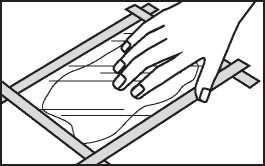

9. After a minimum of 2 hours - just prior to surgery - remove the bandage and occlusive wrapping. Wipe off the Denela Cream 5%. Analgesic efficacy may decline if application time is >5 hours.
The anaesthetised donor site may appear either pale or red. These reactions are normal and are associated with the skin anaesthesia. Disinfect and prepare the anaesthetised donor site prior to cutting the split skin graft.
Auden Mckenzie (Pharma Division) Ltd
A1000169/3
Q
Auden Mckenzie
Group 11
continued on the other side
2 3 4 5 6 7 8 9 10 11 12 13 14 15 16







|
Product |
UK Denela® 5% Cream |
PIL Code |
A1000169/3 |
Date started 05.04.2013 | ||
|
Artwork |
PIL 8i SPC/TL for 30g tube pack |
Version |
001 |
aw/v Final outlined files - 12.11.2013 |
Author |
MP-AUD |
|
Notes |
Size: 380mm high x 340mm wide (flat) 4pp - 380mm high x 170mm wide (folded) |
Inside spread 170mm
P2
Inside spread - p3 170mm
Pregnancy and breast feeding
• Talk to your doctor, pharmacist or nurse before using Denela Cream if you are pregnant, may become pregnant or are breast-feeding.
• The medicines in Denela Cream (lidocaine and prilocaine) are passed into breast milk.
However, the amount is so small that there is generally no risk to the child.
Ask your doctor or pharmacist for advice before taking any medicine if you are pregnant or breast-feeding.
Important information about some of the ingredients of Denela Cream
Denela Cream contains macrogolglycerol hydroxystearate (hydrogenated polyoxyl castor oil).
This may cause skin reactions.
Alternatively, a line of cream of about 3.5 cm squeezed from the 30 g tube is equal to 1 g of cream. When you apply the cream, it is very important to exactly follow the instructions below:
1. Squeeze 1/4 tube in a mound on the area to be anaesthetised.

Overall height
380mm
Always use Denela Cream exactly as your doctor, pharmacist or nurse has told you. You should check with your doctor, pharmacist or nurse if you are not sure.
Do not use Denela Cream on the following areas:
• Cuts, grazes or wounds.
• Where there is a skin rash or eczema.
• In or near the eyes.
• Inside the nose, ear or mouth.
• In the back passage (anus).
• On the genitals of children.
Using Denela Cream
• Where to put the cream, how much to use and how long to leave it on for will depend on what it is needed for.
• Your doctor, pharmacist or nurse will put the cream on or show you how to do it yourself.
• If applying the cream yourself, before you do you must get dressings from your doctor, nurse or pharmacist to use with Denela.
• When Denela Cream is used on the genitals, a doctor or nurse should supervise its use.
Adults and adolescents aged 12 years and over:
Use on the skin before small procedures (such as having a needle put in or minor skin operations)
The cream is put on to the skin in a thick layer. Your doctor, pharmacist or nurse will tell you where to put it.
The usual dose is 2 g applied for 1 to 5 hours under a dressing.
Use on the skin before hospital procedures (such as split-skin grafting) that require deeper skin anaesthesia
The usual dose is 1.5 g to 2 g of cream for each area of skin that is 10 cm2 (10 square centimetres) in size, applied for 2 to 5 hours under a dressing. The attached 'Information for the Healthcare Professional' contains further information for your doctor or nurse.
Use on larger areas of newly shaven skin before outpatient procedures (such as hair removal techniques)
The usual dose is 1.5 g of cream for each area of skin that is 10 cm2 (10 square centimetres) in size, applied for 1 to 5 hours under a dressing. Denela Cream should not be used on an area of newly shaven skin larger than 600 cm2 (600 square centimetres, e.g. 30 cm by 20 cm) in size. The maximum dose is 60 g.
Use on genital skin before injections of local anaesthetics (adult men only)
The usual dose is 1 g of cream for each area of skin that is 10 cm2 (10 square centimetres) in size, applied for 15 minutes under a dressing.
Use on genital skin before minor skin surgery (such as removal of warts for adults only)
The usual dose is 5 g to 10 g of cream applied for 10 minutes with no dressing. The medical procedure should then start immediately.
Use on leg ulcers before cleaning or debridement
The usual dose is 1 g to 2 g of cream for each area of skin that is 10 cm2 up to a total of 10 g. The cream is put on under an airtight dressing such as plastic wrap. This is done for 30 to 60 minutes before the ulcer is to be cleansed. Remove the cream with cotton gauze and start cleansing without delay.
Denela Cream can be used before cleansing of leg ulcers for up to 15 times over a period of 1-2 months.
Children:
Use on the skin before small procedures (such as having a needle put in or minor skin operations):
Application time: approx. 1 hour.
Newborn infants and infants under the age of 3 months: Up to 1 g of cream on a skin area not larger than 10 cm2 (10 square centimetres) in size. Application time: 1 hour, not more. Only one single dose should be given in any 24 hour period.
Infants aged 3-12 months: Up to 2 g of cream on a total skin area not larger than 20 cm2 (20 square centimetres) in size. Application time: approx. 1 hour, maximum 4 hours.
Children aged 1 -6 years: Up to 10 g of cream on a total skin area not larger than 100 cm2 (100 square centimetres) in size. Application time: approx. 1 hour, maximum 5 hours.
Children aged 7-11 years: Up to 20 g of cream on a total skin area not larger than 200 cm2 (200 square centimetres) in size. Application time: approx. 1 hour, maximum 5 hours.
A maximum of 2 doses at least 12 hours apart may be given to children over 3 months of age in any 24 hour period. Applying the correct dose
Cream applied to a circular area with a diameter of about 18 mm (a 1 pence coin) and depth of about 5 mm is equal to 1 g of Denela cream.
2. Do not rub the cream in.
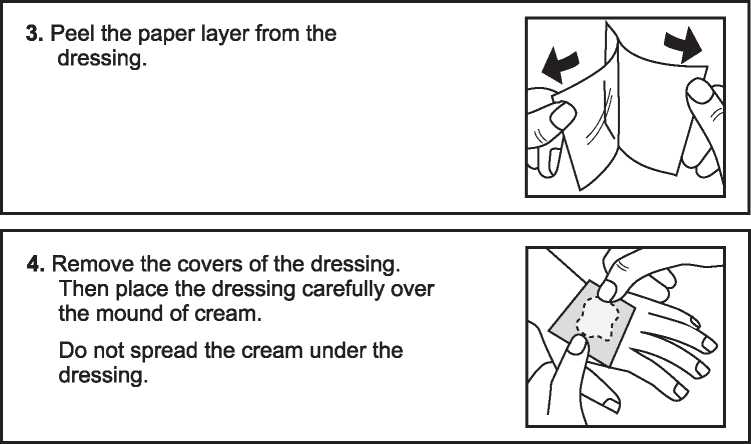
Remove the backing. Smooth down the edges of the dressing carefully.
Then leave it in place for at least 60 minutes.

Your doctor or nurse will take the dressing off and remove the cream just before they do the medical procedure (for example just before the needle is put in).
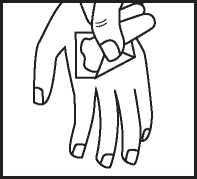
What to do if you get Denela Cream in your eye:
• Do not get Denela Cream in your eyes. This is because it may irritate your eyes.
* If you get Denela Cream in your eye by mistake, rinse your eye well with lukewarm water or
salt (sodium chloride) solution. Be careful to avoid getting anything in your eye until feeling returns.
If Denela Cream is accidentally swallowed, talk to your doctor, pharmacist or nurse straight away.
If you use more Denela Cream than you should:
* If you use more Denela Cream than your doctor, pharmacist or nurse has told you to, talk to one of them straight away, even if you do not feel any symptoms.
* Symptoms of using too much Denela Cream are listed below. These symptoms are unlikely to happen if Denela Cream is used as recommended.
> Feeling light-headed or dizzy.
> Tingling of the skin around the mouth and numbness of the tongue.
> Abnormal taste.
> Blurred vision.
> Ringing in the ears.
> There is also a risk of 'methaemoglobinaemia' (a problem with blood pigment levels).This is more likely in children and when certain medicines have been taken at the same time. If this happens, the skin becomes bluish-grey due to a lack of oxygen.
continued on the other side
ax gf ax ax gx a/ qx ox gx gx gx gx gx gx gx gx gx a/ gx gx gx gx a/ gx gx gx gx y gx y y y y y y y y y y gf g^ y y y y y g^ ax' y y y y y y y y y y y y y y y y y y y y y y y y y y y y y y y y y y y y y y y y y y y y y y y y y y y y y y y y y y y y y y y yy y y y y y y y y y y y
OX OX OX OX Ox OX OX OX Ox Ox OX OX OX Ox Ox OX Ox OX OX OX OX OX OX OX Ox OX. Ox Ox OX OX OX OX Ox OX OX OX OX Ox OX ^X OX OX Ox OX ^X Ox OX OX OX OX Ox OX OX OX OX Ox OX OX OX OX Ox OX ^X Ox OX OX OX OX Ox OX OX OX OX Ox OX ^X OX OX OX OX OX Ox OX OX OX OX Ox OX ^X OX OX OX OX OX Ox OX OX OX OX Ox OX ^X OX OX OX OX OX Ox OX OX OX OX Ox OX OXOX OX OX Ox OX OX OX OX Ox OX ^X OX
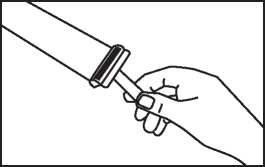
1. Shave the skin of the selected donor site area. Clean the area of skin with alcohol.
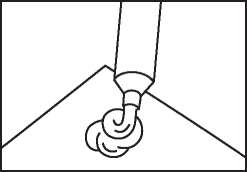
3. Squeeze out between 'h -1 (30g) tube of Denela Cream 5% per 100cm2 on the area of the donor site to be anaesthetised.
PIL height 296mm

2. Select the exact area of the donor site by using the graduated ruled edge of this leaflet, e.g.
10cm x 10cm or 10cm x 20cm - and mark this area using an indelible thick marker pen to delineate the margins of the site.
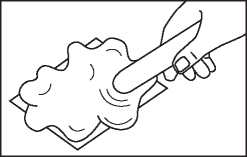
4. Spread the Denela Cream 5% using the enclosed spatula to form an even, thick layer. It is important to cover completely the entire donor area including over the marked margins of the site.
5. Take a strip of transparent occlusive plastic film wrapping cut to the appropriate size (slightly larger than the area of the donor site).
Carefully apply the wrapping to cover completely the layer of Denela Cream 5%.
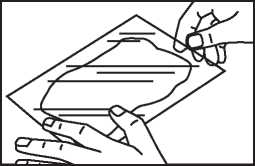
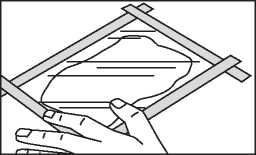
6. Smooth down and tape the edges of the occlusive film wrapping to the skin using a surgical synthetic adhesive tape.
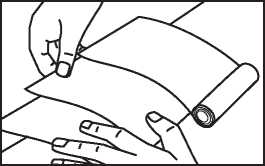
7. Wrap the entire site using an elastic crepe bandage to protect the site and avoid leakage of the
Denela Cream 5% - but avoid undue compression and do not wrap too tight.
Leave the Denela Cream 5% and occlusive wrapping in place for at least 2 hours.
As a reminder, the time can be written on the wrapping or bandage.
TL height 84mm